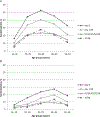Seroprevalence of 9 Human Papillomavirus Types in the United States, 2005-2006
- PMID: 26320259
- PMCID: PMC11357742
- DOI: 10.1093/infdis/jiv403
Seroprevalence of 9 Human Papillomavirus Types in the United States, 2005-2006
Abstract
Background: A 9-valent human papillomavirus (HPV) vaccine, licensed in 2014, prevents 4 HPV types targeted by the quadrivalent vaccine (6/11/16/18) and 5 additional high-risk (HR) types (31/33/45/52/58). Measuring seropositivity before vaccine introduction provides baseline data on exposure to types targeted by vaccines.
Methods: We determined seroprevalence of HPV 6/11/16/18/31/33/45/52/58 among 4943 persons aged 14-59 years who participated in the National Health and Nutrition Examination Survey, 2005-2006.
Results: Among females, seroprevalence was 40.5% for any of the 9 vaccine types, 30.0% for any 7 HR types (16/18/31/33/45/52/58), 19.0% for any 5 additional types (31/33/45/52/58), and 18.3% for 16/18. Compared with non-Hispanic whites, non-Hispanic blacks had higher seroprevalence of 31/33/45/52/58 (36.8% vs 15.9%) and 16/18 (30.1% vs 17.8%), while Mexican Americans had higher seroprevalence of 31/33/45/52/58 (23.6% vs 15.9%) (P < .05 for all). In multivariable analyses of data from females, race/ethnicity, number of sex partners, and age were associated with 16/18 and 31/33/45/52/58 seropositivity. Seropositivity was lower among males than among females (P < .001 for all type categories).
Conclusions: In 2005-2006, about 40% of females and 20% of males had serological evidence of exposure to ≥1 of 9 HPV types. Seroprevalence of all type categories, especially HPV 31/33/45/52/58 among females, varied by race/ethnicity.
Keywords: human papillomavirus; racial differences; seroprevalence.
Published by Oxford University Press for the Infectious Diseases Society of America 2015. This work is written by (a) US Government employee(s) and is in the public domain in the US.
Conflict of interest statement
Figures

Comment in
-
HPV Seroprevalence in the United States: Behavior, Biology, and Prevention.J Infect Dis. 2016 Jan 15;213(2):171-2. doi: 10.1093/infdis/jiv405. Epub 2015 Aug 27. J Infect Dis. 2016. PMID: 26320258 Free PMC article. No abstract available.
References
-
- Satterwhite CL, Torrone E, Meites E, et al. Sexually transmitted infections among US women and men: prevalence and incidence estimates, 2008. Sex Transm Infect 2013; 40:187–93. - PubMed
-
- Doorbar J, Quint W, Banks L, et al. The biology and life-cycle of human papillomaviruses. Vaccine 2012; 30(suppl 5):F55–70. - PubMed
-
- Forman D, de Martel C, Lacey CJ, et al. Global burden of human papillomavirus and related diseases. Vaccine 2012; 30(suppl 5):F12–23. - PubMed
Publication types
MeSH terms
Substances
Grants and funding
LinkOut - more resources
Full Text Sources
Other Literature Sources

